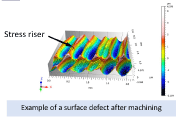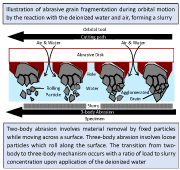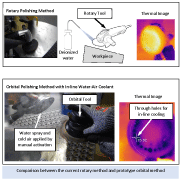E-Archive
Articles
in Vol. 23 - July Issue - Year 2022
A Prototype Orbital Polishing Tool with Through-coolant Capability




Problem Statement
Poor machining of component may generate irregularities on surfaces requiring sufficient material removal to eliminate the defects and achieve roughness parameters and dimensional limits simultaneously. The most common defects in machining are scallop height features, due to poor cutting strategy or tool vibration. Surface peaks are sharp and considered as stress concentration where cracks may be initiated and subsequently propagate, causing fatigue failure, leading to non-compliance of manufacturing standards; accordingly, surface defects must be removed, typically by mechanical polishing while attaining the required standards.
The conventional production method of polishing a component deploys the use of a single-axis rotary tool with one type of abrasive grit size. Typically, the component surface is wetted by external application of deionized water and wiped at intervals to keep it clean, thereby disrupting the process. The heat generated in the existing polishing process is relatively high and will induce thermal damage or deformation to the part. Moreover, the abrasive disk also needs to be checked frequently for wear and replacement. With better heat dissipation by introducing air and deionized water dynamically, the process could be improved in terms of tool performance and finishing quality.
The rotary polishing tool has a single-axis rotational movement where the abrasive pad spins primarily around its axis at high speeds, creating an aggressive cutting action. The challenge of this motion is the generation of lay in the surface texture. The other issue is high rate of material removal associated with rotary polishing which would result in dimensional issues. Thus, it is necessary to test a newly developed orbital tool that can remove surface defects while effectively keeping the part cool, and in continuous motion.
Summary of the invention
This technology relates to a newly developed wet/dry polishing system with in-line cooling capability. The orbital tool combines the aggressiveness of a belt polisher with the ability to produce a fine finish on the workpiece. The orbital motion causes the disk to rotate in a circle and at the same time, the disk oscillates in an eccentric pattern that generates the vibration amplitude. A cold air gun has been added to the system for effective cooling of both tool and workpiece. The abrasive disk is customized with multiple drilled-through holes. The abrasive used has an agglomerated grain structure allowing slurry formulation under wet conditions where smaller grains would easily breakdown into finer particles. This is necessary to produce the required surface texture and protect the workpiece surface from thermal degradation while simultaneously keeping it clean.
Technical Description of the Orbital tool
Concept and prototype design
Random-orbit motion depends on the ratio between the orbital radius and the radius of the disk rotation. Inertia causes the disk to want to rotate in unison with the orbital motion, but friction with the workpiece tempers this motion and causes the disk to slow down, or stop when excessive pressure is applied. The orbital motion causes the disk to rotate in a circle and at the same time, the disk oscillates in an eccentric pattern inside this larger, main rotating pattern.
Media selection for aqueous-vibratory abrasion
The abrasive disk is made of aluminum oxide (Al2O3) with a diameter of 127 mm. Multiple holes are drilled to match the hole pattern on the backing foam pad. The holes in the disk allow the coolant to pass through when the system is activated by water spray valve and cold air gun. The abrasive structure consists of numerous abrasive grains bound to each other by a resin, acting as a bonding bridge. The agglomerated configuration consists of several grains bonded together at different layers in height. As the abrasive wears down by mechanical forces, new grains are exposed for regenerative cutting action. The through-coolant of cold air and water facilitates the evacuation of residue from the disk, making the abrasive clean and effective for subsequent cutting cycles.
Advantages
Experimental trials have successfully demonstrated the performance of orbital polishing, with metallic surface roughness parameters (Ra) reaching a minimum of 0.2 µm using P320 grit size. The tool has the capability for lowering the abrasive disk surface temperatures by up to 80%. Metallographic cross-sectioning proved that there is no surface distortion, strain lines and abrasive particle embedment on the parts. The modified tool design is also effective in cleaning the surfaces and dressing the abrasive disk. It was observed that when the disk’s angle of inclination is above 5º, there will be risk of localized grooving, while 0º angle may result in a poor surface finish.
The key benefits and novelty are:
Controlled removal of defect without reducing significant part thickness
Produces the required roughness free-form surfaces by texturizing instead of aggressive cutting
Wet condition induces the formulation of paste or slurry to match the effect of vibratory motion
Self-cleaning system and dressing of the tool when the air/water is applied, flushing out debris
Effective heat reduction on the tool and on the workpiece’s direct contact surface area
For Information:
Author: Edgar J Danaraj
Development of the experimental methodology
E-mail: EDGARJEE001@e.ntu.edu.sg
Co-author: Assoc. Professor Yeo Swee Hock
Nanyang Technological University, School of Mechanical and Aerospace Engineering



























